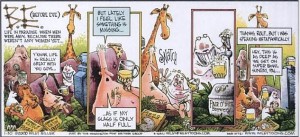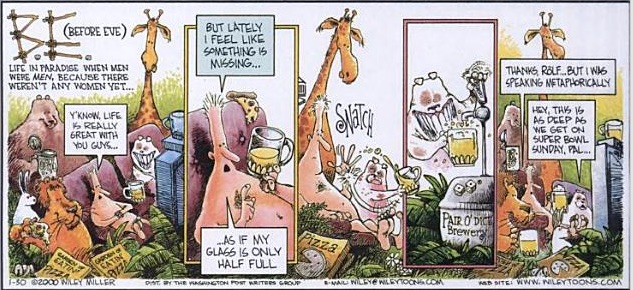
In the satirical comic strip, Non Sequitur by Wiley Miller, there is a series he’s done over the years with the title B.E. (Before Eve), “When men were men because there weren’t any women yet.” In one cartoon panel, Adam is hanging out with his all male animal buddies, drinking beer, eating pizza and watching sports on TV. When he began to get a feeling that something was missing in his life, that his glass was half full, Rolph, his dog friend, took Adam’s beer glass and filled it from the beer tap. Adam attempted to say he was speaking metaphorically, and Rolph interrupted him, saying that was as deep as they should get on Super Bowl Sunday.
Another time when Adam felt he needed something more substantial in his life, Rolf and went to “the Big Guy,” so God invented stout beer. . . . and it was good. Not meant to portray biblical truth, nevertheless the B.E. comics illustrate the duality of fulfillment and the sense of something missing that would have been the experience of a single male “Man” alone within the created order.
“But for Adam there was not found a helper fit for him” (Genesis 2:20). Intriguingly, the first step in God’s making a suitable helper for the man was to have Adam exercise his stewardship responsibilities (Genesis 1:26) in naming the animals. But this naming process had an additional purpose besides being the first taxonomy of the animal kingdom. God was preparing Adam to see his need for a mate and helper.
While he was like the other creatures because he was made from the ground, Adam was also unique among these creatures because he was created in the image of God and commissioned by God to rule over the order (Genesis 1:26-30). Kenneth Mathews noted in his commentary on Genesis that a systematic search among all creatures would have demonstrated to Adam that he was alone among all created beings in the sense that he was one of a kind. He could not fill the earth and subdue it; he could not be fruitful and multiply, if he continued on in the condition of being “alone” without a suitable helper.
So God caused a deep sleep to fall over Adam. And while he slept, God took a rib (sēlāʿ) from the man and made from it a woman (Genesis 2:21-22). In The Theological Wordbook of the Old Testament, John Hartley suggested the Hebrew word for rib here is better translated as “side.” This passage is the only time in the Old Testament where sēlāʿ is used in reference to man. With the exception of Second Samuel 16:13, it has an architectural sense, referring to the sides of objects like the ark of the covenant (Exodus 25:12, 14); or a location within a building (Exodus 26:35).
It can also mean a side chamber (I Kings 6:5; Ezekiel 41:6). “This picture describes the intimacy between man and woman as they stand equal before God.” As Matthew Henry famously said: “That the woman was made of a rib out of the side of Adam; not made out of his head to rule over him, nor out of his feet to be trampled upon by him, but out of his side to be equal with him, under his arm to be protected, and near his heart to be beloved.” Kenneth Mathews commented that the symbolism of the “rib” is that the man and the woman are fit, suitable companions for one another—socially and sexually. So when God presented the woman to the man, Adam spoke for the first time:
Then the man (ʾādām) said,
“This at last is bone of my bones
and flesh of my flesh;
she shall be called Woman (ʾiššâ),
because she was taken out of Man (ʾîš).” (Genesis 2:23)
The poetic form of the verse underscores the importance of this creative event: God made a distinct helper and companion for Adam that was his metaphysical equal, for she was taken out of him. A suitable companion could not be found among the animals, so God made a fit helper out of the flesh and bone of Adam himself. God fashioned the man’s rib into a woman (Genesis 2:22); so the man (ʾādām) named his companion woman (ʾiššâ), because she was made from man (ʾîš). In Beyond Sex Roles, Gilbert Bilezikian commented that since woman was taken from man, there could be no confusion about her full participation in humanity. “She was made from the same material as his own body. From one being, God made two persons.”
The woman is not a mere extension of the man. She is created with a unique individuality in her own right without a suggestion of inferiority. Yet being formed from the man’s body, she has a continuity with him not found in any other creature. Hartley again made a helpful observation: “Therefore woman’s origin makes it possible for a man and a woman to establish a dynamic relationship in which they become ‘one flesh’ (cf. Gen 2:24).”
There seems to be a unique relationship being acknowledged here. Bruce Waltke pointed out that while the Genesis narrator named Adam by his relationship to the ground (ʾădāmâ) in Genesis 2:7, Adam named himself in 2:23 in relation to his wife. The word for “woman” here (ʾiššâ) is the most commonly used Hebrew word for woman and wife in the Old Testament. The Hebrew word for man (ʾîš) is typically used for an individual male in contrast to ʾādām for mankind. Frequently it is also rendered as husband (Ge 3:6). While the use here of ʾîš andʾiššâ may be nothing more than a playful literary device, the surrounding context announced the beginning of a close and intimate relationship between the man and the woman.
It reflects God’s desire to provide man with a companion who would be his intellectual and physical counterpart. The permanency intended in the relationship is expressed in the assertion that man should leave his parents and cleave to his wife.
A close relationship between the man and the woman is also suggested in Adam saying: “This is at last bone of my bones and flesh of my flesh.” The phrase ‘flesh and bone’ is used figuratively to denote kinship (e.g., Genesis 29:14; Judges 9:2; 2 Samuel 19:12-13). It can also have a covenantal meaning, as in 2 Samuel 5:1-3. Genesis 2:24 reinforced a covenantal meaning, when the narrator commented: “Therefore a man shall leave his father and his mother and hold fast to his wife, and they shall become one flesh.” Leaving father and mother and clinging to one’s wife signifies the ending of one allegiance and the beginning of another. “Already Scripture has sounded the note that marriage is a covenant, rather than an ad-hoc, makeshift arrangement.” (Victor Hamilton, The Book of Genesis Chapters 1-17) Paul clearly had this covenantal understanding in mind with his quotation of Genesis 2:24 in Ephesians 5, where he discussed marriage and how it represented the relationship between Christ and the church.
The ‘one-fleshness’ emphasizes that in a biblical marriage, the man’s primary loyalty is to his wife. Despite the bond of kinship with his parents, he is to leave them and cling to his wife; creating a new kinship bond with her. Theirs is to be a fully shared life. “Marriage is the most profound bond that exists between two human beings; within it nothing can be withheld. . . . All other relational claims are subordinate to those of marriage.” Marriage was designed as a life-long exclusive relationship. It simultaneously puts a barricade around the husband and wife, while demolishing all barriers between them. This one-flesh union of husband and wife is actually a reunion, where the flesh and bone that God took from the man to form the woman is returned to him within the marriage covenant as his wife.
But their marital union was a union of mortal flesh: like “a wind that passes and comes not again” (Psalm 78:39). Any merely human manifestation of the redemptive purposes of God would fall short, ultimately pointing us to its needed future fulfillment in Christ. This was as true of pre-Fall marriage as it was of post-Fall marriage. The profound significance of marriage as it was instituted in Genesis chapter two would only become fully revealed with the completed work of Christ (Ephesians 5:31-32).





